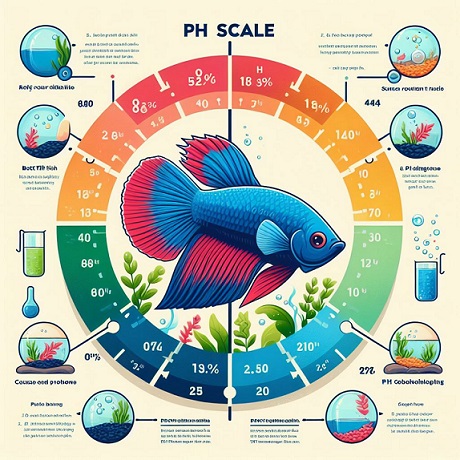Maintaining optimal pH levels is crucial for the health and well-being of your betta fish. These beautiful fishes, also known as Siamese fighting fish, require a stable and healthy pH environment to thrive. In this article, we will delve into the significance of pH levels for betta fish and establish a clear connection between pH and their overall health.
What are the Normal pH Levels for Betta Fish?
The normal pH for betta fish is between 6.8 and 7.5. To ensure they lead a healthy and fulfilling life, it’s essential to pay attention to the pH and other environmental factors.
The pH level of water directly influences the chemical reactions that occur within a betta fish’s body. Extreme pH levels is dangerous, as it can stress the fish, making them more susceptible to diseases, affecting their immune system, and impacting their ability to thrive. Therefore, understanding and maintaining the right pH is key to ensuring the longevity and vibrancy of your betta fish.
How to Create an Ideal pH Levels for Nurturing Betta Fish
An ideal betta fish tank has to mimic their natural habitat. Betta fish originate from slow-moving waters, such as rice paddies, ponds, and shallow streams in Southeast Asia. These environments typically have a slightly acidic to neutral pH. Mimicking these conditions in a home aquarium is essential for replicating the betta fish’s natural habitat.
The ideal pH range for bettas is generally between 6.5 and 7.5. It’s crucial to monitor and maintain this range to ensure their physiological processes, enzyme activity, and overall health remain optimal.
Deviation from the recommended pH range can lead to stress, adversely affecting the betta’s health. Regular monitoring through water testing kits and adjustments with pH regulators or natural methods are essential to keep the pH within the ideal range.
What Causes Rise and Fall in pH in Betta Fish Tanks
Here are some factors that can cause the pH of a betta fish tank to fluctuate:
1. Water Source Variations
If you’re using tap water for instance, the water treatment processes can introduce variability in pH levels. Chlorine and Chloramines in these water treatment chemicals may contribute to pH shifts in the betta fish tank.
2. Substrates
pH-Neutral Substrates such as gravel, sand, or specifically designed aquarium substrates act as pH buffers, promoting stability. Careful substrate selection is essential to influence and maintain the desired pH range for betta fish.
3. Biological Processes
Biological processes like nitrogen cycle can impact the pH of a betta tank. The ongoing nitrogen cycle involves chemical transformations that release or consume hydrogen ions, influencing pH. Nitrification, the conversion of ammonia to nitrite and nitrate, can also lead to a gradual decrease in pH.
4. Plant Presence
Photosynthesis can impact your betta tank’s pH. During the process, plants absorb carbon dioxide, thus affecting pH levels in the aquarium. In the same vein, plants play the role of buffers, as they absorb excess acidic compounds, stabiliing pH.
5. Bioload and Organic Matter:
When organic matter breaks down, it releases acidic compounds, influencing pH. Fish waste and uneaten food can also contribute to increased ammonia levels, impacting pH in the betta fish tank.
How to Maintain Stable pH in Betta Fish Tanks
Ensuring a stable pH in your betta fish tank is vital for the health and well-being of your aquatic companions. Here are key strategies to maintain a consistent pH level:
1. Regular Water Changes
Changing your tank’s water regularly is essential to maintaining a stable pH for your betta fish. Regular water changes help dilute any accumulated acids or bases in the aquarium water.
Water changes also remove organic waste and uneaten food, preventing the buildup of substances that can impact pH. Furthermore, introducing fresh, stable water can help replace any lost essential minerals.
How to Change Water in Your Betta Tank
- Change 15-20% of the water weekly, or as needed based on water testing results.
- You can use a siphon to remove debris from the substrate.
- Treat new water with a water conditioner to neutralize harmful chemicals and maintain a consistent pH.
2. Proper Filtration
Using a proper betta fish tank filter is important for maintaining a stable betta fish pH. Beneficial bacteria in the filter help convert ammonia to nitrite and then to nitrate, influencing pH. Filters also eliminate organic waste, preventing the release of acidic compounds.
Tips for Maintaining Effective Filtration
- Choose a filter appropriate for the size of your betta fish tank.
- Clean or replace filter media regularly to prevent the accumulation of debris.
- Ensure a well-established nitrogen cycle for biological filtration.
3. Monitoring and Controlling Other Water Parameters
Some other parameters to monitor include:
- Temperature: The recommended temperature for a betta fish tank is typically between 78 °F (ca. 26 °C) and 80 °F (ca. 27 °C). Betta fish are tropical freshwater fish and thrive in warmer water temperatures. It’s essential to use a reliable aquarium heater to maintain a stable and suitable temperature for your betta. Maintain a stable temperature within the recommended range for betta fish.
- Ammonia, Nitrite, and Nitrate Levels: Regularly test and manage these parameters to support a healthy nitrogen cycle.
- Hardness and Alkalinity: Understanding and adjusting these parameters can contribute to pH stability.
Can Changes in pH Levels Cause Betta Fish Disease?
Yes, changes in pH levels can indeed contribute to the onset of diseases in betta fish. Betta fish are sensitive to their environment, and maintaining a stable pH is crucial for their overall health and well-being. Here’s how fluctuations in pH can impact betta fish and lead to diseases:
- Stress Response:
Rapid changes in pH levels can induce stress in betta fish. Stress weakens their immune system and makes them more susceptible to diseases.
Prolonged exposure to stress can lead to various health issues, including bacterial and fungal infections.
2. pH-Related Diseases:
Sudden drops or increases in pH can create an environment conducive to certain diseases. For example:
- pH Drop: Acidic conditions can stress the fish and make them prone to diseases like fin rot.
- pH Increase: Alkaline conditions may contribute to infections and parasites.
3. Impact of pH Changes on Beneficial Bacteria:
The beneficial bacteria responsible for the nitrogen cycle are pH-sensitive. Fluctuations in pH can disrupt the nitrogen cycle, leading to an accumulation of harmful substances like ammonia.
Elevated ammonia levels, resulting from a disturbed nitrogen cycle, can cause ammonia poisoning and stress the fish.
- Weakened Immune System:
- pH fluctuations can compromise the betta fish’s immune system. A weakened immune system makes them more susceptible to various infections and diseases.
- Diseases such as ich (Ichthyophthirius multifiliis) and velvet (Oodinium) can take hold when the fish’s natural defenses are compromised.
Conclusion
In conclusion, maintaining optimal pH levels is important for betta fish health and well-being. These captivating aquatic companions thrive within a specific pH range, and deviations from this optimal environment can lead to stress, weakened immune systems, and an increased susceptibility to diseases.



